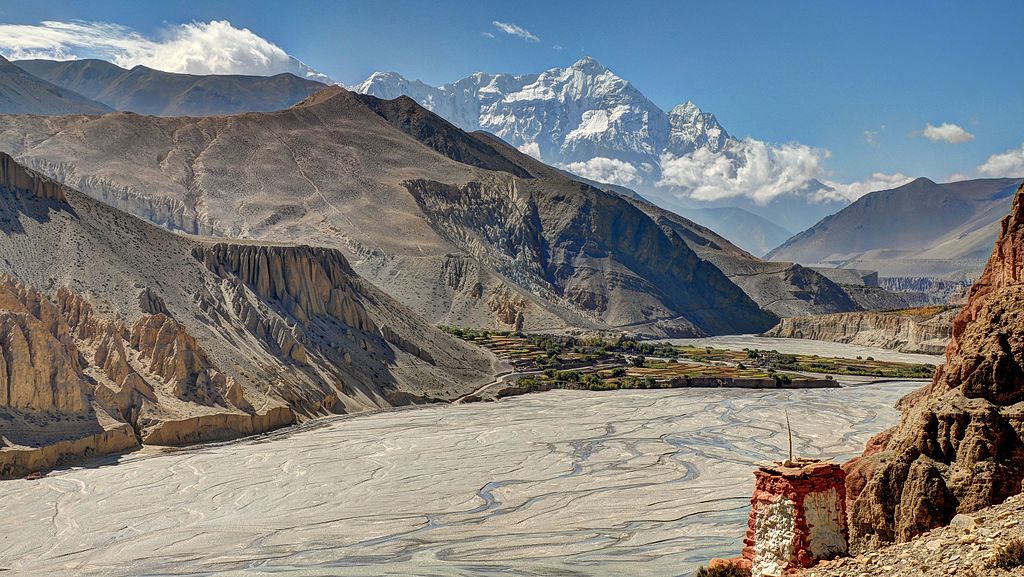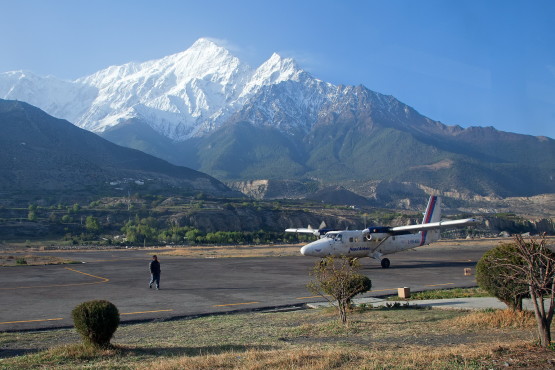- HOME
- Destination
- Adventure Activities
- About Us
- BLOGS
- CONTACT US

The word “Mustang” is a Tibetan word, which means “Plain of Aspiration.” Mustang is one of the most remote areas of Nepal and is very isolated from the outer world. While Mustang is a remote region, it is visited by thousands of tourist yearly. Visitors ignore the remote location of this place and pay a visit to witness the traditional Tibetan culture and the beautiful views all around.
Mustang is bordered by Tibetan plateau, and the tallest mountains like Annapurna and Dhaulagiri, including several other peaks above 7,000 meters are also situated here. The elevation of Mustang rises from 1,372 to 8,167 meters.
Mustang is one of the districts of Nepal, and the entire district is within the Annapurna Conservation Area, which happens to be the largest protected area of Nepal. Jomsom is the headquarter of Mustang, and it is spread in the area of 3,573 km square. Annapurna Conservation Area Project (ACAP) is primarily overseen by Development programs and tourism management.
So, for the trekking purpose in the Upper Mustang region, you need a permit from Annapurna Conservation Area Project (ACAP), Trekkers Information Management System (TIMS) and Special Permit for Upper Mustang issued from Department of Immigration, Kathmandu, Nepal.
Mustang is a vast and arid valley characterized by eroded canyons, colored stratified rock formations and barren high-altitude deserts. There is the average amount of annual rainfall which is less than 260 mm at Jomsom in Lower Mustang. In spring and autumn, the place generally gets dry, but summer monsoons bring some precipitation. In winter, the mean minimum monthly air temperature falls -2.7 degree Celsius, while in summer the maximum monthly air temperature reaches up to 23.1 degree Celsius.

Mustang is very rich in biodiversity, especially in trans-Himalayan biodiversity. There are many species of wildlife enough to study. This place is rich in trans-Himalayan biodiversity and as per the Wikipedia there are five species of zooplankton, seven species of nematode, tow mollusc species, one annelid species, twenty-five insect species, eleven amphibian species, eight lizard species, five snake species, one spider species, five snake species, 105 bird species and 29 species of mammal. Wildlife like snow leopard, musk deer, Tibetan wild ass and Tibetan gazelle are inhabitant to this region. Also, there are five species of butterfly, two species of frog, two bird species, one reptile species, extinct species of mollusk and several species of mammals.
Mustang is very rich in plants which have medicinal value, and there are aromatic plants as well; these plants have very high economic and ethnomedicinal values. Local people use the plants of Mustang for food, spices, fiber, fuel, medicine, dye, tannin, gum, resin, handicraft, roofing materials, religious purpose, and others. As per the study, the medicinal use of 121 plant species was recorded.
The vegetation of Mustang is characterized by steppe type and has grasslands with scrub. In the lower region, there is mixed broad-leaved forest which consists of rhododendrons, pines and acer species. Above the elevation of 5,000 meters, there are Rhododendron anthopogon, Potentilla biflora, and Saxifraga. About 3,245 of Mustang is covered by forest. Above the elevation of 5,800 meters, there is almost no vegetation because of extreme coldness. Near the area of Jomsom, the forest covers end, and it is very limited in the Upper Mustang region, which falls in the Alpine climatic area.
There are mostly legends rather than the facts in constituting the data regarding the history of Mustang. As per the belief, Mustang was once a part of Tibet named Ngari area. In the 14th century, Malla Empire (capital Sinja in western Nepal) acquired the most of Nagari. Due to its strategic location, Mustang controlled the trade between the Himalayas and India from 15th to 17th century. Then in 1380, Lo Manthang became an independent kingdom under Ame Pal. Ame Pal carried out the most of the founding and buildings in the region of Lo Manthang, but the only existent of his work is the still-intact Kingdom of Lo.
At the end of 18th century, Mustang was annexed by the King Prithvi Narayan Shah while in quest of unifying the smaller states and constituting them as a one. Then with the overthrown of the monarchy in Nepal, Mustang became one of the districts of Nepal.
Muktinath temple of Mustang is one of the sacred places for Hindu and Buddhist too. As per the Hinduism, Muktinath is also referred to as Mukti Kshetra means “place of liberation.” It is situated at the altitude of 3,710 meters. Muktinath is one of the most ancient Hindu temples which is dedicated to the Lord Vishnu. According to the Sri Vaishnava sect of Hinduism, Muktinath is the 106th out of 108 Divya Desam (premium temples). There are 108 bull face tapes in the outer courtyard of the temples and devotes of Muktinath takes a bath from all the water tapes no matter how cold it is.
As per the Buddhism, Guru Rinpoche, also known as Padmasambhava, the founder of Tibetan Buddhism, meditated at Muktinath on his way to Tibet. Buddhists, along with a Buddhist monk, does all the worshipping rituals of the temple.

Muktinath
Lo Manthang is a rural municipality of Mustang. Lo Manthang is mainly known for the former Royal place, monasteries, and tall whitewashed mud-brick walls. The Royal Palace was built about 600 years back, and it is a nine-cornered, five-storey structure. The palace suffered multiples cracks in the devastating earthquake of April 2015.
There are four temples in Lo Manthangs which are also the most visit site of this place. Those temples are: Jampa Lhakhang/Jampa Gompa, also known as “God House” was built in the early 15th century, Thubechen Gompa was also built in the 15th century, Chodey Gompa is the main gompa and Choprang Gompa, which is also known as “New Gompa.”
Mustang has a most magnificent collection of 10,000 human-made cave. Those caves are dug into the side of valleys of the Mustang. Archaeologist and researchers found partially mummified human bodies and skeleton which are at least 2,000-3,000 years old. Buddhist paints, manuscripts sculptures, and several artifacts came in discovery which is from the 12th to the 14th century. In 2007, a shepherd found a collection of 55 cave paintings which depicted the life of Buddha. These caves can leave anyone with amazement, because of its intriguing making and location.
Jomsom lies at an altitude of 2,700 meters in Mustang. It is also referred to as Dzong-Sampa or New Fort. Jomsom is a small town, which is a tourist hub. Jomsom also has the airport which provides domestic flights from Pokhara. Jomsom is a charming little town, which offers the view of mountains like Dhaulagiri and Nilgiri. There are trails which are very scenic that ranges from the delightful forest of colorful rhododendron trees to rocky cliffs and the desert. You can also use Jomsom as your base for exploring the Kali Gandaki gorge, which is the deepest canyon in the world. This charming town has a mix-culture combination of Hindu and Tibetan Buddhism.

Jomsom
Your email address will not be published.Required fields are marked *
You must be logged in to post a comment.
0 Comments on "Mustang, Nepal: The Forbidden Kingdom"